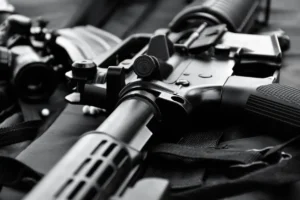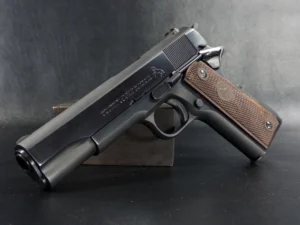Key Takeaways:
- John Browning didn’t just design guns — he reshaped the whole idea of what firearms could be: From the M1911 to the Auto-5, his creations weren’t just innovative for their time — they still influence modern gun design today. It’s wild how something cooked up in the early 1900s can still feel relevant, even essential, in the 2020s.
- Browning firearms walk the line between rugged practicality and timeless craftsmanship: Whether you’re hunting, shooting at the range, or collecting vintage pieces, there’s a certain feel — a balance and integrity — that sets them apart. These aren’t disposable tools; they’re heirlooms with bite.
- The Browning name isn’t coasting on nostalgia — it’s still evolving: They’re not stuck in the past. Today’s Brownings bring new materials, updated designs, and user-friendly tech to the table, all without losing what made them great in the first place. It’s a legacy brand that still knows how to push things forward.
Say the name “Browning” to a gun person and watch their face light up. Whether it’s a crusty old collector, a weekend trap shooter, or even a history teacher trying to bring a dusty old textbook to life, the reaction is usually the same: respect. Admiration. Sometimes, borderline reverence. And honestly? It’s earned.
Because Browning isn’t just another firearms brand — it’s the blueprint. A cornerstone of modern gun design. A kind of quiet titan that’s been changing the game for well over a hundred years.
At the heart of all this? One man. John Moses Browning. The kind of guy whose name should probably be mentioned in the same breath as Edison or Tesla — if you’re into trigger mechanics instead of light bulbs.
From the very first semi-auto shotgun to the mighty M1911, his ideas didn’t just work — they stuck. And the wild part? A lot of them are still in play today. That’s the kind of legacy you don’t manufacture in a marketing department.
But let’s not get ahead of ourselves.
The Spark: John Moses Browning and the Birth of a Legacy
John Browning didn’t stumble into gun design. He was practically born into it. His dad, Jonathan, was already tinkering with firearms out in Ogden, Utah. So young John? He grew up around anvils, barrels, and the smell of gun oil. While other kids were probably making stick forts, he was figuring out how to improve firing mechanisms.
By the time he was in his early twenties, Browning had already filed his first patent. And then, in 1878, he officially opened the Browning Arms Company. That was the ignition point. What followed wasn’t just a career — it was a revolution in firearms design.
John wasn’t flashy. He was practical, methodical, and a little obsessive. But that’s exactly why his guns worked. They didn’t try to impress you with gimmicks. They just did the job — and did it better than anything else on the market.
Eventually, he teamed up with Fabrique Nationale in Belgium, and that collaboration? That’s what pushed things into overdrive. If you’ve ever fired a Browning Hi-Power or even just admired one from across a glass case, you’ve seen what came out of that partnership.
He didn’t just design guns. He designed systems. Solutions. Entire blueprints that reshaped what shooters and soldiers expected out of their weapons. And that ripple effect? Still going strong today.
Guns for the People — And the Battlefield
One of the things that made Browning different was how well he danced between civilian and military needs.
Hunters, sport shooters, and everyday folks found something dependable in Browning’s civilian lineup. Guns like the Auto-5 — the world’s first semi-automatic shotgun — made shooting faster, smoother, and more intuitive. It was elegant, too. The kind of gun you didn’t mind handing down through the generations.
But Browning’s real impact? It came into sharp focus during war.
World War I. World War II. Korea. Vietnam. Chances are, if there was a major 20th-century conflict, a Browning design was right there in the thick of it.
A few hits from the Browning Hall of Fame:
- The M1911 — Still one of the most loved pistols ever. Carried by U.S. forces for over 70 years. Accurate, simple, tough as hell.
- The BAR (Browning Automatic Rifle) — This beast walked the line between portability and raw power. It gave troops the edge they needed in chaotic combat zones.
- The M2 “Ma Deuce” — A .50 caliber machine gun that, not kidding, is still being used today. Think about that. A gun designed before the Great Depression is still in active service. That’s not just innovation — that’s immortality.
And then there’s the Hi-Power — a 9mm pistol designed in the ’30s that went on to serve over 50 armies worldwide. It had a higher-capacity magazine before that was even a thing. It was ergonomic before that was a buzzword.
Browning didn’t just influence military small arms. He rewrote the manual.
The Icons: Auto-5, Hi-Power, M1911 — and Beyond
Okay, let’s dig a little deeper into the star players.
The Auto-5 was where everything changed. Before it, shotguns were pretty straightforward: bang, pump, repeat. But this thing cycled itself. Like magic. You pull the trigger, it absorbs the recoil, ejects the shell, loads the next one, and is ready to go. It was fast. Efficient. And a total game-changer in hunting and sport shooting.
Then there’s the Hi-Power — arguably one of the most important pistols of the 20th century. High-capacity magazine. Great balance. Brilliantly simple design. And it just felt right in your hand. No wonder militaries across the globe adopted it. When something works, word gets around.
The M1911 deserves its own chapter in any gun history book. A single-action, semi-auto .45 ACP pistol that’s become a rite of passage for many shooters. There’s something deeply satisfying about firing one — like you’re tapping into a century of American grit.
And we can’t forget the BAR. Heavy? Yes. But it gave individual soldiers a level of firepower that previously required a whole team. It could be a bit unwieldy, sure, but in the right hands, it was devastatingly effective.
All of these weren’t just guns. They were benchmarks.
What’s Under the Hood: Understanding Browning’s Specs (Without Going Cross-Eyed)
Let’s be honest — technical specs can feel like alphabet soup if you’re not in the mood. But they matter. And with Browning, they’re actually worth paying attention to because the engineering behind each spec wasn’t phoned in.
So here’s a quick rundown of what you’re looking at when you pop the hood on a Browning:
- Caliber — This one’s straightforward. It’s the size of the bullet the gun shoots. Browning firearms span everything from .22 to .50 BMG depending on the model. Pick what suits your needs — squirrels or steel plates or…well, tanks.
- Action Type — Semi-auto, bolt, lever — Browning makes them all. Each has its own flavor. Want speed? Go semi. Crave precision? Try bolt-action.
- Barrel Length — Generally, longer equals more accurate. But also more awkward in tight spaces. It’s always a tradeoff.
- Weight — Big if you’re out hiking with your rifle or carrying a shotgun all day. Lighter is easier, but it can mean more recoil.
- Ergonomics — This is the part nobody talks about enough. How the gun actually feels in your hands. Browning puts thought into this — grips, stock shape, balance. It all adds up to comfort.
The good news? Browning doesn’t make anything clunky or awkward. They’re shooters’ guns, through and through.
Got Issues? Browning’s Warranty Has Your Back
Let’s talk warranties — not exactly sexy, but it matters when you’re spending real money on a firearm.
Browning’s warranty is pretty solid. It covers manufacturing defects, bad parts, or factory goof-ups. What it doesn’t cover: you dropping it off a tree stand or doing weird home gunsmithing in your garage.
Pro tip: register your gun and hang onto your paperwork. If something ever goes sideways, it makes the whole process smoother.
Also — and this is important — if you’re buying vintage or secondhand, the warranty probably won’t follow. But hey, that’s part of the collector’s journey.
Serial Numbers: Tiny Stamps with Big Stories
If you’ve ever found yourself squinting at a serial number on an old Browning and wondering where it’s been — good news. You can actually look that stuff up.
Browning’s serial number system is pretty decent, and with a little digging, you can figure out what year your gun was made, what model, sometimes even where. That’s gold for collectors and a cool trivia point for everyone else.
It also helps weed out fakes, which — yep — are a thing. Especially with highly collectible models like the Hi-Power.
Knowing your gun’s history gives it context. A little soul. And if you’re lucky, maybe even a story worth telling.
The Collector’s Bug: Why Vintage Brownings Still Matter
Vintage Browning firearms are catnip for collectors. And it’s not just about the old wood stocks or blued steel. It’s about what they represent.
These guns were made in an era where craftsmanship was king. You didn’t just punch parts out on machines and slap them together. Things were fitted. Tuned. Refined.
Owning a vintage Browning is like owning a piece of industrial art — but one that still works.
The most desirable models?
- Pre-war Hi-Powers.
- Belgian-made Auto-5s.
- Early M1911 variants.
- Limited-run editions with engraving or high-grade wood.
Condition is everything. Original parts? Even better. If it’s got a box and papers, now you’re talking serious collector money.
But beyond the numbers, it’s about having something that connects you to a time, a place, a mindset. These guns weren’t mass-market fluff. They were built to last — and they did.
Choosing Your First (or Fifth) Browning
Whether you’re new to the scene or already have a safe full of steel and walnut, picking a Browning is more about vibe than specs.
Ask yourself: What do I want this for?
- Hunting upland birds? Get a Citori over-under or a Silver semi-auto.
- Long-range targets? X-Bolt is your friend.
- Home defense? Some still swear by the old-school Hi-Power.
- Just want something cool and historic? M1911. Every time.
Fit matters. So does balance. Don’t be afraid to shoulder a few different models and see what feels right. Sometimes the gun picks you.
And hey, if you’re stuck? Ask someone who’s been down this road. Gun people love talking about their gear. You’ll get more advice than you probably asked for — but buried in all that, you’ll find something useful.
Browning, Now: Not Just Coasting on History
You’d think a brand like Browning might sit back and just ride the nostalgia wave. But they’re not.
Today’s Browning lineup includes modern manufacturing techniques, synthetic stocks, Cerakote finishes, and even some smart-tech features creeping into the picture. But they still build around that same core principle: don’t screw up the basics.
The company is paying attention to the shifting tides, too. Changes in hunting laws, optics trends, even safety features — they’re not tone-deaf. They adapt. But not at the cost of what made Browning… well, Browning.
You don’t stick around for 140+ years by accident. You evolve — without losing your soul.
Final Shot: Why Browning Still Matters
So yeah — Browning is more than a logo or a nameplate stamped into steel. It’s a story that stretches from a dusty little gunsmith shop in Utah to battlefields, forests, and firing ranges around the world.
It’s the kind of legacy that doesn’t just survive — it shapes the next generation of shooters.
You pick up a Browning, and whether it’s a hundred years old or brand new, you’re holding onto something that works. Something that matters. Something that’ll probably still be working long after we’re gone.
And that? That’s a damn fine thing.
Frequently Asked Questions
Who founded Browning and when?
Browning was founded by John Moses Browning, one of history’s most influential firearms designers. He introduced his first design in the late 19th century and founded the company soon after.
What makes Browning firearms unique?
Browning is renowned for its groundbreaking designs, blending function, reliability, and craftsmanship. Many of the company’s innovations, such as semi-automatic firearms and modern over/under shotguns, have become industry standards.
How has Browning influenced the firearms industry?
Browning’s designs have heavily shaped the development of civilian and military firearms. Many of his designs have been adopted by other manufacturers, and some are still used today by military forces worldwide.
What type of customers does Browning cater to?
Browning serves hunters, sport shooters, collectors, and enthusiasts who value high-quality, reliable firearms. Its products are popular among both professional users and recreational shooters.
Are Browning firearms suitable for collectors?
Yes, many Browning models, such as limited-edition and discontinued designs, are highly sought after by collectors for their craftsmanship, innovation, and historical significance.
